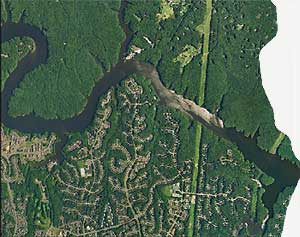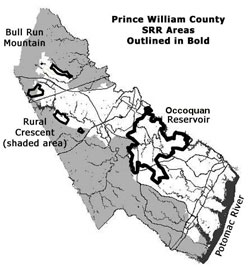| Mid-County Semi-Rural Residential (SRR) District | ||||
Public Water and Sewer Proposed for Davis Ford Road Corridor June 12 2012 -- PWC Service Authority is holding a public input meeting on the Occoquan Forest Wastewater Treatment Plant, including consideration of extending public water and sewer to the Davis Ford Road corridor.
The introduction of public sewer in rural areas always raises legitimate citizen concerns about increased residential densities and the County's Semi-Rural Residential district, intended in part to protect the Occoquan Reservoir, is no different. Once you have the sewer and water capacity, it's hard to resist developer pressure to increase densities. To protect the County's long-range vision, any sewer lines added to the Mid-County area should be sized to accommodate only existing development and planned development at the current Semi-Rural Residential densities called for in the Comprehensive Plan. Anything larger would be nothing more than a ratepayer subsidy for speculative development. |
||||
Proposed Changes for the 2000 Comprehensive Plan Land Use Chapter Update February 2 2010 --- The Comprehensive Plan Land Use Chapter (approved Feb. 2 by a 7-1 vote) included several 11th hour surprise amendments that had not been made available to the public in advance. and resulted in substantive changes to the draft text for the SRR district, which is intended to protect the Occoquan Reservoir and buffer the Rural Crescent from development area densities. One amendment put forward by Supervisor Jenkins deleted text that would have formed an Occoquan Reservoir Protection Zone, or overlay district, which had been strongly supported by civic groups and area residents. Chairman Stewart supported the amendment, saying he recommended deleting the proposed overlay district and wanted no changes to the SRR district except for increased buffer standards along Davis Ford Road and Prince William Parkway, which would improve community appearance. The Chairman went on to explain that one of the reasons for the creation of the SRR district in the first place was to prevent high density development in that area that ran into the reservoir. More than 1.2 million people rely on the Occoquan Reservoir for clean drinking water. The land draining into the Occoquan covers 590 sq. mi., including portions of Prince William, Fairfax, Fauquier and Loudoun Counties. Approximately 40% of the watershed area lies in Prince William County. Is Prince William County’s sole effort to protect our public drinking water supply by limiting development near the Reservoir to 2.5 acre lots adequate? Should we do more or can we rely on the efforts of others to save the day? Check out this quick comparison showing what our neighbors are doing, then share your views with Supervisors.
January 23 2010 --- On February 2 Supervisors will vote on new land use policies that would change the development rules in the SRR mid-County district, which covers key portions of the Occoquan Reservoir watershed. The current proposal offers developers a density bonus to encourage the “preservation of natural resources.” The County would calculate allowed densities for new development using the parcel(s) net acreage (excludes environmental resources) EXCEPT for clustered development, where densities would be calculated using the gross acreage (includes environmental resources). In theory, the density bonus would reward developers for clustering new homes on lots as small as a half acre, leaving contiguous areas of environmentally sensitive land undeveloped. At first glance, this seems like a fair compromise that gives developers an incentive to protect the environment. However, the devil’s in the details and the proposed text includes a huge loophole – “preservation” areas do not have to be either undeveloped or permanently protected. Keep reading... Developers request more houses in Mid-County/Occoquan Reservoir area For developers, more houses means more profit so it’s no surprise that their requests to add residential density to the Comprehensive Plan are a focus of every update.
Time and again, the same two areas attract developer attention and community opposition – the Rural Crescent and the Mid-County/Occoquan Reservoir area. The current Comprehensive Plan calls for Suburban Rural Residential (SRR) development - an average of 1 house per 2.5 acres, or 0.4 houses/acre. This means that a developer with a 100-acre parcel can reasonably expect County approval for 40 new houses. Developers seeking approval for Suburban Rural Residential (SRR) development receive a density bonus. In other land use categories, the County removes the acreage covered by environmentally sensitive features (such as Resource Preservation Areas) BEFORE calculating allowed densities. Not so for the Mid-County SRR area. The area around the Occoquan Reservoir gets a density bonus because the County calculates the number of new houses based on total acreage, including the environmentally sensitive features. More countable acres equal more houses. Not surprisingly, developers claim this is not good enough. They want more houses Mid-County and are putting forward a concerted effort to increase those densities from 1 house/2.5 acres to 1 house/1 acre. This would more than double the number of new houses that could be built. There many good reasons to support very low densities in the Mid-County area, especially considering that this area was intended to:
Compared to Fairfax County’s purchase of 5,000 acres along their side of the Occoquan Reservoir in the 1950’s, it surely seems that limiting residential densities on our side of the Reservoir is the least we could do.
But more houses in this area means more impervious surfaces, more stormwater runoff and more septic fields near the Occoquan Reservoir, our public drinking water supply. Impervious surfaces are important because they are directly linked to water quality. Numerous studies show that when just 10% of a drainage area is covered with hardened surfaces, the streams in that watershed are seriously degraded. According to published statistics, the current Mid-County densities – 0.4 houses/1 acre – would result in an average of 12% impervious cover. If approved, the developers proposal would increase Mid-County densities to 1 house/1 acre, and increase the average impervious cover to 20%. If it's true that developers require subsidies to protect the environment, the County has an entirely different problem that density bonuses won’t begin to solve. In fact, the Environment Chapter is also currently under review and developers have already expressed considerable concerns about the higher standards proposed in the draft plan. Adding densities Mid-County does not support the County’s smart growth goals to protect our public drinking water, preserve a low-density buffer to protect the Rural Crescent, build communities that create a sense of place, keep our taxes low and increase densities near existing transportation infrastructure, such as the VRE. Keep reading... |
![]()
Home | Upcoming Events | About Us | Resource Issues | News | Local Contacts |Maps
Publications | Youth Education |FAQ's | Links | Membership








